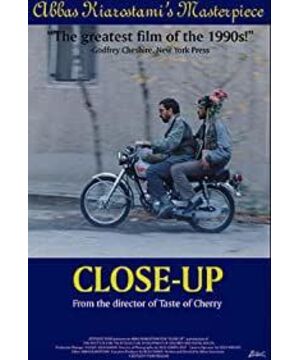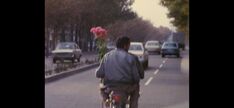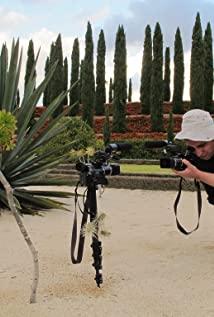Excerpted from "The Taste of Cherries: Abbas Talks About Movies", Abbas said to the trainees during the 7th workshop.
1
There is a back and forth between fantasy and reality in "Close-Up". For the trial scene, I planned to use three cameras in a real courtroom. One was used for close-up shots of defendant Hussein Sabqian, the second was used for wide-angle shots of the courtroom, and the third was used to highlight Sabqian's relationship with the judge. Almost immediately, one camera broke and the other was so noisy that I had to turn it off. We ended up having to move the only camera that worked to another location, which meant missing out on Sabuccian's footage. So, after just an hour of trial and the judge leaving because he was busy, we shot Sabchian behind closed doors for nine hours. I talked to him and suggested something he could say in front of the camera. Ultimately, we recreated most of the trial scenes without the judge present. In "Close Up," I cut in a few shots of the judge from time to time to make it look like he's always there, which constitutes one of the biggest lies in my film. These films are admittedly full of tricks—like many of my other films, they appear to be reflections of reality, but are often quite different things—but they are completely believable. Everything is a lie, nothing is true, yet all imply the truth. Whether I agree with or approve of something in a story is secondary to whether I believe it. If I don't believe in a movie, I'm out of touch with it. The first time I watched a Hollywood movie, I fell asleep before the end, and even a child could feel that the fictional characters in the story had nothing to do with real life and themselves. My work lies in such a way that people believe it. I offer lies to the audience, but I do so convincingly. Every filmmaker has his own interpretation of reality, which makes every filmmaker a liar. But these lies are meant to express a deeply human truth.
2
"Close-Up" At the end of the film, we see Sabchian leave prison and meet the real Makmalbaf for the first time. Sabchian hugged Makmalbaf affectionately, and they left together on a motorcycle. I followed in a car, listened to them talking, and quickly realized that none of what they said was appropriate for the movie. The problem is that Makmalbaf knew he was being taped and Sabchian didn't. This is not a dialogue I can use, but just two opposing monologues. The fake director is too real and the real director is too fake. Also, the film is wrapping up, and leaving unedited dialogue between the two could take the film in a new direction. The narrative must gradually lead to a climax, not open up. This dialogue might also make Makmalbaf the protagonist, but I hope Sabchian is at the heart of the story from start to finish. If something else comes along, "Close Up" can become unbalanced, as Marlon Brando first appears in the final ten minutes of a movie.
I stayed up all night thinking about how to make this paragraph work, and then came up with a solution that made the mic look broken. When I told the editor I wanted to stutter the recording, he looked at me in disbelief. He blatantly refused to take part in such a crazy thing, so I did it myself. In that scene, you only hear words intermittently. Everything else is incomprehensible. Now I see it as one of the most important moments in my film, especially whenever someone complains because they want to know what Makmalbaf and Sabchian said. Audiences are forced to prepare themselves to think beyond the screen. They want to know what's off the screen, which means they have to fill the gaps themselves.
3
I wondered if I could really do what Sabchian did. Who is entirely happy to be themselves? Don't we all sometimes imagine what it's like to be someone else? There is a Sabucian hidden in each of us. When I was 16, I copied "Bilitis Song" for a girl and told her I wrote it. Each of us is looking for a different identity.
To me, Feature is about the power of love. When someone loves something so intensely—in this case, a movie—he can be astonishingly brave. To be able to tell such a gorgeous lie to the Ahankakh family, Sabchian has transformed himself into a true artist. When I came to the family to set the scene for Sabuccian's arrest, he told one of the family's sons that, in fact, he wasn't cheating on them. Ultimately, he kept his word and brought in a film crew for him. The family was made into the movie anyway. Are we the film crew of Sabuccian's dreams? I was stunned. What Sabchian said to the Ahankach family may be part of his fantasy, but in a way he was right because the family ended up playing a version of it in "Close Up" Own. Movies have the magical power to fulfill our desire to be others.
4
Sound can be an effective mechanism for suggesting things we don't see, giving images a third dimension. In "Close-Up," we hear sirens in the background as Sabchian pretends to be Makmalbaf on the bus to sign the book, suggesting that something isn't quite right.
5
My first screening of "Close Up" was in Munich, and the projectionist got the film sequence wrong, but I didn't say anything because I found his serendipitous version better than mine. I re-edited the film when I got home, and moved the encounter on the bus—which was the beginning of the film—to the middle of the trial.
Being able to respond in creative ways to disasters that occur so often, rather than flashy technology, is something I admire. Hafez teaches us that contingency also has value. Take advantage of the serendipitous and unexpected. Cherish the inevitable and embrace the contingent.
6
The scene that raises the most questions of all my movie scenes is the scene where a tin can roll down the street at the beginning of "Close Up." How many comments have I heard about a single moment like this! When I explained where this image came from, people didn't believe me. They were expecting something very profound, but the fact is that there was a slope in front of the house we were filming. The important events of the story take place inside the house, and I wanted to show the idleness of the man standing outside. I created a scene where he slowly rolls an empty spray can downhill. I just love the image and don't think I'll have many chances to capture a shot like that, and I know it's a shot that moves the audience in some way. We also had time to kill and a few feet of film in the camera. A perfect match.
7
I was introduced to someone like this: "Here's the director of 'Close Up'." And to that, the guy -- who wasn't in the film industry -- said, "I don't think that movie had a director." What a wonderful thing concept. An unintentional compliment.
View more about Close-Up reviews








